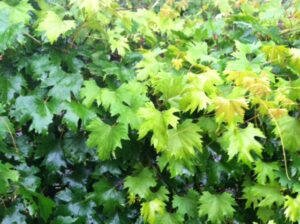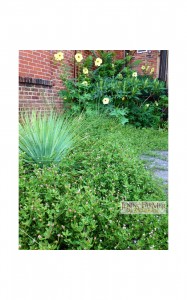20 Tough Plants for Parking Lot Gardens
For 80 years this was a parking lot. Can we reclaim, plant, green up even a little fringe of the space?
It’s a tough spot. Days often reach just over 100 F which means asphalt surface could be about 140F in the daytime. That stresses many plants. Even plants that can tolerate that but need an evening reprieve. Unfortunately, asphalt holds heat longer into the night than concrete, the plants don’t get that cool down.
So plants and soil organisms bake for weeks at a time.
Then it rains. With little drainage, hundreds of gallons of water fill the planting beds. Instead of baking, the plants boil and steam.
Things get worse. Cars back up to the plants spewing exhaust. Dozens of people walk through every day, but they have their own work to get to. No one knows what to do even if they do notice damaged plants. Pots of flowers fry.
We made it something really special. Not a garden in the typical sense. We made it a wild urban garden using techniques and plants that thrive with these challenges. We made it totally organically, with no tilling, no synthetic fertilizer, no plastic irrigation pipes, and no weekly mow and blow. It’s a designed planting that functions like a naturally occurring plant community using plants and techniques adapted for zone 8 and hotter climates.
The garden shapes were based on foot traffic patterns and spirals. We cut then ripped up the asphalt. Then we planted the right plants. No double digging, no tilling, no noise or gas equipment. The curves soften the space and they look great from an upper deck. There’s an elongated spiral cut into the middle, but it’s a shape that’s easy to walk around.
One of the company owners told me it was a hurricane symbol, but to me, it’s enough that it’s a spiral, a compelling shape that represents a journey. Conceptually, it’s the journey this little bit of land took; once wooded, then a sandy parking lot, later asphalted and one day after people are gone, woods again of a kind we can’t imagine.
The tree in the center is the center of a storm because it’s definitely not a politically correct tree. In fact, it’s maligned. But it’s one of the few trees, trash tree or not, that will thrive in the middle of asphalt, grow fast, not drop lots of trash, be dramatic winter and summer and fit in a narrow space. In short, parasol tree will live and give shade where almost no other tree can.
Over three years, this garden has worked. The only care it gets is a serious pruning back of the rambunctious ground cover, two or three times a year. You know, any groundcover that can grow out over 140 F asphalt has me in awe. One year, we pruned back the grass in the dead of winter.
We did it, we made a garden. Not a garden that people come to photograph. But a garden that lives thrives, that’s taken back some man-made hard surface and brought a little beautiful green chaos, physically and philosophically, to an abused bit of land.
The Plants Are:
Evergreen Groundcovers and Evergreen Grasses: Pholox pilosa, Ardisia japonica ‘Andre The Giant’, Equisetum hymenelle ‘Sheldon Short’, Packera tomentosa, Spartina bakeri, Phyla nodiflora (frog fruit; see pic at end).
Deciduous perennials: Crinum ‘Pink Trumpet’ and ‘Alamo Village’, Muhlenbergia ‘White Cloud’, Abelmoschus maniohot, Cyperus diffusus.
Shrubs: Chaenomeles ‘Pink Storm’,
Rhaphidophyllum histrix
Small Tree: Firmiana simplex
Vines; Vitis (a variety with an elegant leaf), Pandorea jasminoides
About half the plants hail from South Carolina. But by the numbers, it’s 10 to 1 — native to exotic. (Sounds sort of xenophobic when you write it like that. Rest assured, I love the new-Americans too.) In fact, since this is a totally man-made environment, you could say there are no plants that are actually ‘native’ to an asphalt parking lot, behind a brick store, that floods when the gutters empty swimming pools of water onto soils that have a hundred years of accumulated motor oil, dry cleaner fluid, pee, tire parts, paint thinner and who know what all.
But all of these plants will thrive and make the comings and going of people and animals, just a little more gentle over the years.
Here are two of the guys relaxing after the planting: one built like a football player and one like a basketball player and both with big smiles after an intense work day-a perfect team of young men starting out on their journeys. (owners nephew & friend who did all the work of installation with her)


